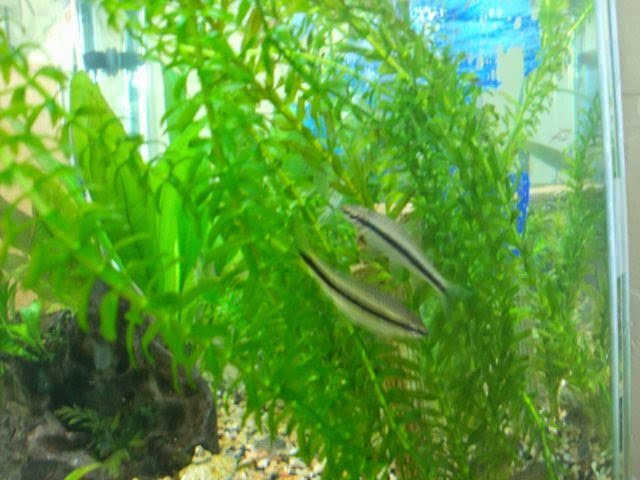I have never acquired this fish simply because I do not have a suitable habitat where it will be at its best. Although I have battled brush algae in the past, I have had no issues with this for several years now once I got things in balance. But as you asked for info on the fish itself, that I can provide; this is cut and pasted from a profile I wrote of this species a couple years back. As you will see below, this fish attains six inches, and should be in a group. With just two, there is a possibility that trouble may ensue. The size and shoaling nature are the reasons I don't have this fish.
Crossocheilus langei
Family: Cyprinidae, Subfamily Labeoninae
Common Name: Siamese Algae Eater
Origin and Habitat: SE Asia: Sumatra (Indonesia) and Malaysia, possibly into Borneo, Thailand and Myanmar; the type species was collected near Palembang, Sumatra. Inhabits flowing streams and rivers having a substrate of sand, gravel and boulders.
Compatibility/Temperament: Generally peaceful, suitable for the larger community aquarium with other peaceful fishes such as barbs, danios and most loaches. A shoaling fish by nature, it does best in a group of 6 or more and a distinct hierarchy will be formed within the group.
Siamese Algae Eater Diet
In its native habitat, it grazes on aufwuchs, consuming algae and phytoplankton. A high vegetable diet is necessary to avoid an excess of protein which can cause severe internal issues; blanched spinach, peas, zucchini, chopped fruit in addition to algae. This species is well known as a consumer of brush/beard algae [note comments under Description].
Size
Attains 6 inches (16 cm).
Minimum Tank Suggestion
48 inches in length.
Water parameters for Siamese Algae Eater
Soft to medium hard (5-15 dGH), slightly acidic to slightly basic (pH 6.5 to7.5), temperature 22-26C/72-78F.
Description
The common name Siamese Algae Eater is regularly applied to several related but distinct species. The species Crossocheilus langei is the one most often encountered in the hobby as the "Siamese Algae Eater" [SAE] and is the best at eating black brush [aka red beard] algae. The "true" SAE is actually Crossocheilus siamensis, a species initially described by H.M. Smith in 1931 as Epalzeorhynchus siamensis and moved by Banarescu into the genus Crossocheilus in 1986, and which has probably never been seen by hobbyists since the holotype [the specimen collected and used for the description] is the only one known. To further confuse, C. siamensis is now considered a synonym for the actual species name, Crossocheilus oblongus.
Confusion abounds with this fish, beyond the above. There are several near-identical species within Crossocheilus, and they are occasionally seen in the hobby. Their usefulness as "algae eaters" is variable,depending upon the species. Then there are two other fish often confused with the SAE, known as the False Siamese Algae Eater, Garra cambodgiensis, and the Flying Fox, Epalzeorhynchos kalopterus. Both of these regularly appear in the hobby, but neither will handle brush/beard algae like the common SAE. The False SAE can be distinguished by the dark lateral band that ends at the caudal peduncle whereas on the subject fish this band continues into the caudal fin. The Flying Fox has white-edged red and black coloured fins, not clear fins as in the subject species.
As noted under Origin, this fish occurs in flowing waters and is intolerant of high nitrates and any build-up of organic waste, requiring clean, well-oxygenated water; it is an active swimmer and thus needs space. It will therefore be best in a river or stream aquascape having a reasonable current from the filter along with a substrate of gravel, sand and pebbles, with larger rocks simulating boulders and some bogwood added. As noted under Compatibility/Temperament, it should be kept in a group of 6 or more so that the natural interaction between fish can be enjoyed.
As mentioned under Diet, vegetable foods must form the bulk of its diet; protein foods will lead to health problems. Properly cared for, this species can live 10 years or longer.
The species was first described in 1860 by P. Bleeker, though the genus name was incorrectly given as Crossocheilos (Crossocheilichthys).






